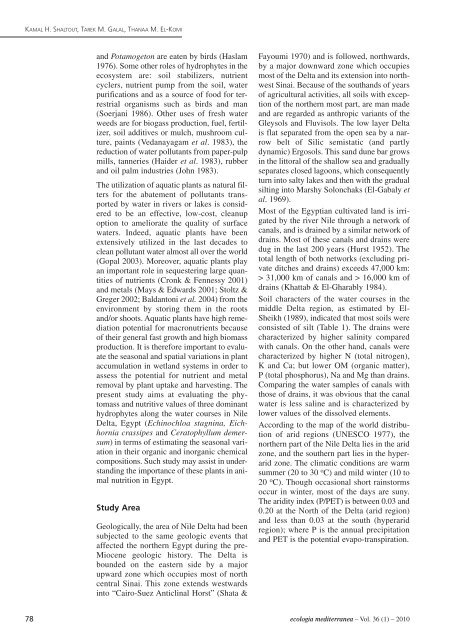Revue internationale d'écologie méditerranéenne International ...
Revue internationale d'écologie méditerranéenne International ...
Revue internationale d'écologie méditerranéenne International ...
You also want an ePaper? Increase the reach of your titles
YUMPU automatically turns print PDFs into web optimized ePapers that Google loves.
KAMAL H. SHALTOUT, TAREK M. GALAL, THANAA M. EL-KOMI<br />
78<br />
and Potamogeton are eaten by birds (Haslam<br />
1976). Some other roles of hydrophytes in the<br />
ecosystem are: soil stabilizers, nutrient<br />
cyclers, nutrient pump from the soil, water<br />
purifications and as a source of food for terrestrial<br />
organisms such as birds and man<br />
(Soerjani 1986). Other uses of fresh water<br />
weeds are for biogass production, fuel, fertilizer,<br />
soil additives or mulch, mushroom culture,<br />
paints (Vedanayagam et al. 1983), the<br />
reduction of water pollutants from paper-pulp<br />
mills, tanneries (Haider et al. 1983), rubber<br />
and oil palm industries (John 1983).<br />
The utilization of aquatic plants as natural filters<br />
for the abatement of pollutants transported<br />
by water in rivers or lakes is considered<br />
to be an effective, low-cost, cleanup<br />
option to ameliorate the quality of surface<br />
waters. Indeed, aquatic plants have been<br />
extensively utilized in the last decades to<br />
clean pollutant water almost all over the world<br />
(Gopal 2003). Moreover, aquatic plants play<br />
an important role in sequestering large quantities<br />
of nutrients (Cronk & Fennessy 2001)<br />
and metals (Mays & Edwards 2001; Stoltz &<br />
Greger 2002; Baldantoni et al. 2004) from the<br />
environment by storing them in the roots<br />
and/or shoots. Aquatic plants have high remediation<br />
potential for macronutrients because<br />
of their general fast growth and high biomass<br />
production. It is therefore important to evaluate<br />
the seasonal and spatial variations in plant<br />
accumulation in wetland systems in order to<br />
assess the potential for nutrient and metal<br />
removal by plant uptake and harvesting. The<br />
present study aims at evaluating the phytomass<br />
and nutritive values of three dominant<br />
hydrophytes along the water courses in Nile<br />
Delta, Egypt (Echinochloa stagnina, Eichhornia<br />
crassipes and Ceratophyllum demersum)<br />
in terms of estimating the seasonal variation<br />
in their organic and inorganic chemical<br />
compositions. Such study may assist in understanding<br />
the importance of these plants in animal<br />
nutrition in Egypt.<br />
Study Area<br />
Geologically, the area of Nile Delta had been<br />
subjected to the same geologic events that<br />
affected the northern Egypt during the pre-<br />
Miocene geologic history. The Delta is<br />
bounded on the eastern side by a major<br />
upward zone which occupies most of north<br />
central Sinai. This zone extends westwards<br />
into “Cairo-Suez Anticlinal Horst” (Shata &<br />
Fayoumi 1970) and is followed, northwards,<br />
by a major downward zone which occupies<br />
most of the Delta and its extension into northwest<br />
Sinai. Because of the southands of years<br />
of agricultural activities, all soils with exception<br />
of the northern most part, are man made<br />
and are regarded as anthropic variants of the<br />
Gleysols and Fluvisols. The low layer Delta<br />
is flat separated from the open sea by a narrow<br />
belt of Silic semistatic (and partly<br />
dynamic) Ergosols. This sand dune bar grows<br />
in the littoral of the shallow sea and gradually<br />
separates closed lagoons, which consequently<br />
turn into salty lakes and then with the gradual<br />
silting into Marshy Solonchaks (El-Gabaly et<br />
al. 1969).<br />
Most of the Egyptian cultivated land is irrigated<br />
by the river Nile through a network of<br />
canals, and is drained by a similar network of<br />
drains. Most of these canals and drains were<br />
dug in the last 200 years (Hurst 1952). The<br />
total length of both networks (excluding private<br />
ditches and drains) exceeds 47,000 km:<br />
> 31,000 km of canals and > 16,000 km of<br />
drains (Khattab & El-Gharably 1984).<br />
Soil characters of the water courses in the<br />
middle Delta region, as estimated by El-<br />
Sheikh (1989), indicated that most soils were<br />
consisted of silt (Table 1). The drains were<br />
characterized by higher salinity compared<br />
with canals. On the other hand, canals were<br />
characterized by higher N (total nitrogen),<br />
K and Ca; but lower OM (organic matter),<br />
P (total phosphorus), Na and Mg than drains.<br />
Comparing the water samples of canals with<br />
those of drains, it was obvious that the canal<br />
water is less saline and is characterized by<br />
lower values of the dissolved elements.<br />
According to the map of the world distribution<br />
of arid regions (UNESCO 1977), the<br />
northern part of the Nile Delta lies in the arid<br />
zone, and the southern part lies in the hyperarid<br />
zone. The climatic conditions are warm<br />
summer (20 to 30 o C) and mild winter (10 to<br />
20 o C). Though occasional short rainstorms<br />
occur in winter, most of the days are suny.<br />
The aridity index (P/PET) is between 0.03 and<br />
0.20 at the North of the Delta (arid region)<br />
and less than 0.03 at the south (hyperarid<br />
region); where P is the annual precipitation<br />
and PET is the potential evapo-transpiration.<br />
ecologia mediterranea – Vol. 36 (1) – 2010
















